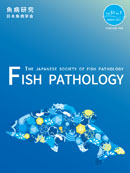
- |<
- <
- 1
- >
- >|
-
Takanori Ishikawa, Daiki Komatsu, Shingo Nonaka, Tatsuya Mori, Korenor ...Article type: Research Article
2022 Volume 57 Issue 3 Pages 69-75
Published: September 15, 2022
Released on J-STAGE: October 14, 2022
JOURNAL FREE ACCESSThe causal relationship of atypical cellular gill disease (ACGD) and Plecoglossus altivelis poxvirus-like virus (PaPV) in ayu Plecoglossus altivelis was studied through a transmission experiment in which naive fish were exposed to the filtrate of a homogenate of diseased fish gills containing PaPV. ACGD symptoms, including lethargy and abnormal swimming such as staying away from the water current with open opercula, were observed in the fish exposed to the virus at 4 days post-exposure (dpe) at 20°C. The cumulative mortality in the virus-exposed fish groups with and without sodium nifurstyrenate pretreatment was 82% and 56%, respectively. Dead fish showed atypical gill epithelial cells on gill filaments with PaPV DNA at 107–109 copies/mg level. In addition, fish were experimentally infected at different rearing temperatures of 18°C, 23°C and 28°C. Fish death was first observed at 15 and 10 dpe in the experimental groups at 18°C and 23°C, with cumulative mortality of 58% and 42%, respectively. However, there was no mortality in fish reared at 28°C. These results suggest that the etiological agent of ACGD in ayu is PaPV, and ACGD occurrence can be influenced by the rearing water temperature.
View full abstractDownload PDF (1183K) -
Soetsu Yanagi, Tohru Mekata, Yoshiaki Imaoka, Kazuo OgawaArticle type: Research Article
2022 Volume 57 Issue 3 Pages 76-82
Published: September 15, 2022
Released on J-STAGE: October 14, 2022
JOURNAL FREE ACCESSIn 2013, four cases of digenean infection occurred among 0-year Seriola dumerili, imported from China and subsequently cultured in Kagoshima Prefecture, Japan. In each case, a single immature worm was recovered from the abdominal cavity, kidney, or skeletal muscle, associated with black viscous substances, probably of parasite origin, suggesting that the parasite was migrating within the fish body. From morphological and molecular analyses, the digenean was identified as Hirudinella ventricosa. No such infection was recorded among 1,968 cultured Seriola spp. examined in Kagoshima during 2012–2018 except for the four cases. In 2017, black to brown substances were noticed in the fillets of Seriola quinqueradiata at a processing factory. The fish with contamination had been cultured for two years from wild seeds caught along the coast of Kagoshima Prefecture. No worm was found, but the 28S rRNA gene sequence analysis demonstrated that they were originated from H. ventricosa. Both the infection of S. dumerili and the contaminated fillets of S. quinqueradiata are assumed to be the cases of larva migrans caused by the hirudinellid digenean.
View full abstractDownload PDF (851K) -
Shinya Mizuno, Mahito Miyamoto, Makoto Hatakeyama, Yoshitomo Katsumata ...Article type: Research Article
2022 Volume 57 Issue 3 Pages 83-94
Published: September 15, 2022
Released on J-STAGE: October 14, 2022
JOURNAL FREE ACCESSThe present study investigated the genotype of Ichthyobodo spp. that caused six cases of ichthyobodosis in various salmonid species cultured in freshwater, in Hokkaido, Japan, through molecular phylogenetic analysis of the parasite ribosomal RNA gene (rDNA). Polymerase chain reaction (PCR) and scanning electron microscopy (SEM) were performed to distinguish the genotypically differentiated Ichthyobodo spp. The parasites were identified as genotypes I (I. necator sensu stricto), II (I. salmonis), or III (Ichthyobodo sp.). The present PCR method could completely distinguish between genotypes I, II and III using the electrophoresis pattern of PCR products from the parasite rDNA. Our SEM observations were able to SEM observations were able to morphologically distinguish genotype I from other two genotypes, but not between genotype II and III.
View full abstractDownload PDF (768K) -
Osamu Kurata, Miyabi Haneji, Takuya Kawashima, Masaru Yagisawa, Satoru ...Article type: Research Article
2022 Volume 57 Issue 3 Pages 95-102
Published: September 15, 2022
Released on J-STAGE: October 14, 2022
JOURNAL FREE ACCESSThe efficacy of Oxilink-SP, a food-additive-based disinfectant used in the environmental control of livestock pathogens, to prevent Saprolegnia infection of salmonid eggs was evaluated. In the laboratory, Oxilink-SP showed fungicidal activity against 5 species of Saprolegnia after immersion of rainbow trout Oncorhynchus mykiss eggs with Saprolegnia mycelia in a 10,000-fold dilution of Oxilink-SP for 30 min. In salmonid fish hatcheries, following immersion in a 5,000-fold dilution of Oxilink-SP for 30 min per day, hyphal growth on eggs of rainbow trout and white-spotted char Salvelinus leucomaenis was inhibited. This was not the case in masu salmon Oncorhynchus masou which may have been affected by water-borne molds of taxa other than Saprolegnia. Although rainbow trout eggs were slightly affected by treatment with Oxilink-SP in eyed-egg developmental stages and hatching, white-spotted char and masu salmon eggs were not affected. Furthermore, this treatment did not affect the incidence of fry deformity in all tested salmonid fish eggs. These results indicated that the disinfectant can prevent the spread of Saprolegnia species on salmonid eggs in hatcheries. We intend to use Oxilink-SP to safely manage fish eggs.
View full abstractDownload PDF (739K)
- |<
- <
- 1
- >
- >|